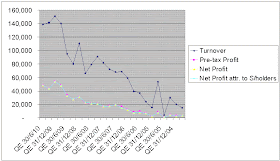The current rebound amongst rubber glove stocks is quite strong. After a sharp drop in price, this rebound makes these stocks really hard to ignore. I have chosen four charts to analyze this sector.
From Chart 1 & 2 below, we can see that Topglov & Kossan are trend-following stocks, giving idealized charts for easy technical analysis. The best way to establish the trend of these stocks is by plotting the 10, 20 & 40- week SMA lines (equivalent to the 50, 100 & 200-day SMA lines). Once the 10 & 20-week SMA lines have cut below the 40-week SMA line (or, the death cross sighted), the stocks would enter into a bearish phase. When the reverse happened [the 10 & 20-week SMA lines have cut above the 40-week SMA line (or, the golden cross sighted)], the stocks would enter into a bullish phase.
Topglov & Kossan have witnessed the death cross 2 or 3 weeks ago. The last time Topglov has experienced the same technical event was in July 2007 while Kossan had its death cross in October 2007. Both stocks then entered into a downtrend until the golden cross appeared in March 2009- signaling the bull rally for these stocks for the past 15 months.
 Chart 1: Topglov's weekly chart as at Oct 20, 2010_11.00am (Source: Quickcharts)
Chart 1: Topglov's weekly chart as at Oct 20, 2010_11.00am (Source: Quickcharts) Chart 2: Kossan's weekly chart as at Oct 20, 2010_11.00am (Source: Quickcharts)
Chart 2: Kossan's weekly chart as at Oct 20, 2010_11.00am (Source: Quickcharts)I have also appended below the charts of Harta & Supermx who show promise of a recovery. In Chart 3, we can see that Supermx has recovered so much ground that its 10-week SMA line is poised to curve above the 40-week SMA line.
 Chart 3: Supermx's weekly chart as at Oct 20, 2010_3.30pm (Source: Quickcharts)
Chart 3: Supermx's weekly chart as at Oct 20, 2010_3.30pm (Source: Quickcharts)In the case of Harta, we can see that the share price has recently revisited its recent high at RM5.60-5.66. While it failed to break above the recent high (and may set the stage for a potential bearish triple top reversal), the fact that it managed to re-test the recent high is very commendable. You may notice that the 10-week SMA line has curved above the 40-week SMA line.
 Chart 4: Harta's weekly chart as at Oct 20, 2010_11.00am (Source: Quickcharts)
Chart 4: Harta's weekly chart as at Oct 20, 2010_11.00am (Source: Quickcharts)What could have triggered the strong rebound in rubber glove stocks? Everything, that can go wrong for this sector, has gone wrong. They are:
1. a normalizing demand (& a looming excess production capacity situation);
2. a sharp rise in the prices of rubber latex (see Chart 5) and the cost of other raw material; and
3. an unfavorable movement in the forex rates (albeit a potential short-term relief).
 (Note: TSR 20 index as proxy for rubber latex price)
(Note: TSR 20 index as proxy for rubber latex price)
Chart 5: TSR 20 index & CRB's weekly chart as at Oct 19, 2010 (Source: Rubbernet)Based on fundamental reasons, I am still very skeptical on the near term outlook for rubber glove stocks. However the strong rebound in the share price seems to suggest things are on the mend. We would have a much clearer picture in a few weeks' time, which would come from either more positive technical readings or the release of the financial results for QE30/9/2010 for Supermx, Harta & Kossan (expected in 2nd week of November).

















































